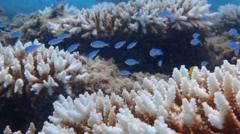Scientists have recorded an alarming and unprecedented level of coral bleaching along the coast of Western Australia (WA), following the area's longest, largest, and most intense marine heatwave ever documented. The bleaching, which occurred between last August and May, resulted from elevated water temperatures that led to significant heat stress on the coral reefs, forcing many to expel the essential algae that provide them with their color and life—a phenomenon known as bleaching, often resulting in fatality.
The extent of the damage, which encompasses a significant stretch of 1,500 kilometers (932 miles), includes regions that had previously displayed resilience to the adverse effects of climate change. Notably, ongoing global coral bleaching has been observed over the past two years due to record-high ocean temperatures worldwide. Generally, eight weeks of extreme heat stress can prove fatal for coral, and preliminary findings from Australia’s marine science agency indicated that many reefs in WA experienced bleaching rates ranging from 15 to 30 percent.
James Gilmour, from the Australian Institute of Marine Science (AIMS), emphasized that the duration, intensity, and geographical spread of this heat stress are unlike anything seen before across most of Western Australia's reefs. In a recent study, AIMS classified the 2024-25 season as the most severe on record for coral bleaching affecting both the northwestern and central reefs of WA.
Previously promising regions such as the Rowley Shoals, north Kimberley, and Ningaloo—each known for previously avoiding significant bleaching—have succumbed to unprecedented damage, suggesting that climate change has finally impacted these areas. The Ningaloo Reef is a UNESCO World Heritage site, similar to the Great Barrier Reef on Australia’s eastern coast, which has also faced considerable coral deterioration over the years.
In response to this calamity, Australian Federal Environment Minister Murray Watt highlighted the urgent need for Australia, alongside the global community, to address the escalating crisis, specifically advocating for the achievement of net-zero emissions to protect coral health. Dr. Gilmour further noted that climate change-induced bleaching events are on the rise in terms of frequency, intensity, and geographic spread. He pointed out that the recovery time for coral reefs—typically between 10 to 15 years—affords them little opportunity to recuperate, given the accelerating pace of climate change.
Historical documentation from the United Nations suggests that even if global temperature increases are limited to 1.5 degrees Celsius above pre-industrial levels, between 70 and 90 percent of the world’s tropical coral reefs will face extinction. The urgent situation in Western Australia reinforces the critical need for immediate and impactful climate action on a global scale to safeguard marine ecosystems.

















